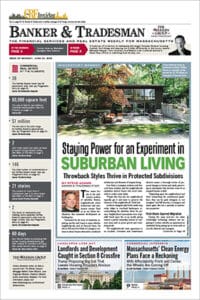
Apartment construction in Greater Boston is around 6 percent of what it was in the 2010s, and that’s likely to send rents soaring even higher. iStock illustration
Don’t look now, but the housing shortage that has driven home prices and rents to insane levels is about to get even worse.
That was the message a leading local developer delivered Thursday at a webinar on the housing crisis I organized through my newsletter, Contrarian Boston.
New apartment construction in the Boston area, after taking a big tumble this year, will all but fall off a cliff at the end the decade, falling to just 4,600 units in 2026, down from an average of more than 8,000 units built each year in the late 2010s, according to projections by Jay Doherty, CEO of Cabot, Cabot & Forbes.
Average rents, in turn, are poised to escalate amid the downturn in new apartment construction, rising to more than $3,200 a unit by 2028, up from roughly $2,700 now, he noted.
Add in $500 a month for utilities and other costs, like pet fees and insurance, and the total cost of renting is headed towards the $4,000 range – or $47,000 a year.
“You had better be earning $140,000 to $150,000 in order to afford a place to live in Greater Boston,” Doherty said.
Headwinds Include More than Debt Costs
The decline comes amid the usual and oft-mentioned culprits of continued financing difficulties and high construction costs.
“That will stay that way until at least 2030,” Doherty said of the big drop in new apartment construction.
The “financing markets … have not reopened” and “by and large there is not financing available for equity or debt in the multifamily Greater Boston market,” Doherty said.
Yet while these are serious issues, they are not the full story.
Sure, our state and local leaders talk a good game about wanting to build more housing.
Yet many of the actions they are taking are making it difficult to all but impossible to build new apartments in an already challenging environment, according to Doherty.
Demands by communities for larger numbers of subsidized, below-market-rate apartments and a tough, new climate-focused energy code are adding to the headwinds and making it difficult if not impossible for many projects to pencil out, Doherty warned.
These added regulatory requirements come atop an already challenging environment for building new housing in Greater Boston.
Once a development site is locked up or outright acquired by a developer, it can take them five years to get a new apartment project approved and built, driving up the project costs and ultimately rents as well.
Simply lining up all the government permits can take three years, he noted.
Suburbs’ Affordability Rules a Barrier
Paradoxically, the looming decline in new apartment construction comes as Gov. Maura Healey and other state officials ramp up efforts to remove local barriers to new housing development.
The Healey administration has been pushing local cities and towns to adopt MBTA Communities law regulations that, on paper anyway, would make it easier to build new apartments and condominiums near T stations.
Attorney General Andrea Campbell, in turn, has taken Milton officials to court in a bid to force the town to comply with the 2021 law.
Yet a number of cities and towns, including, have won a green light from the Healey administration to require 15 percent or more of all new apartments and condos built in these MBTA Communities zones be money-losing, affordable set-asides.
Suburban officials are pushing these high requirements even as new housing production has plunged in Boston, Cambridge and Somerville, after those cities upped their affordable requirements to between 17 and 20 percent, depending on the city.
Doherty said it was challenging enough during relatively robust economic times in the 2010s to finance and build projects with a 12 percent or 13 percent affordable component, the previous standard locally.

Scott Van Voorhis
Many Towns Still Resisting Development
State officials and MBTA Communities law boosters point to a few cities and towns like Lexington, that went above and beyond what the law requires, and clearly zoned with the intent of welcoming more homes.
Lexington, one of the first to get its zoning certified by the state, OK’d denser housing in its historic center. But it also upzoned business nodes near Route 2 and Route 128 that have the kinds of large lots and good utility connections needed to support today’s large apartment buildings – the kinds of buildings investors want to buy into and which Massachusetts’ developers are set up to build.
Meanwhile, a number of cities and towns across the Boston area have decided to comply only on paper with the MBTA Communities law while gaming the new rules to make it as hard as possible to actually build new apartments and other housing.
Doherty said his company initially explored a number of potential apartment projects under the new MBTA Communities zoning, but has since dropped them.
“We worked very hard for the last few years on MBTA Communities. We’ve given that up, except for Lexington,” which, he added, has been as challenging as well.
It is a list that includes Littleton, Natick, downtown Waltham and Plymouth. Littleton for example, placed its multifamily district over acreage that included a warehouse, while Natick placed its multifamily district in its downtown, which is already heavily built out.
“All of these communities are basically finding ways to work around the actual obligation of zoning near MBTA tracks,” Doherty said.
Scott Van Voorhis is Banker & Tradesman’s columnist and publisher of the Contrarian Boston newsletter; opinions expressed are his own. He may be reached at sbvanvoorhis@hotmail.com.






